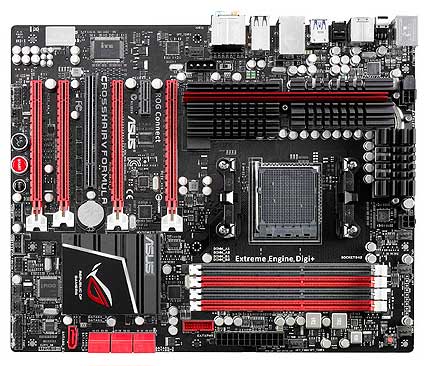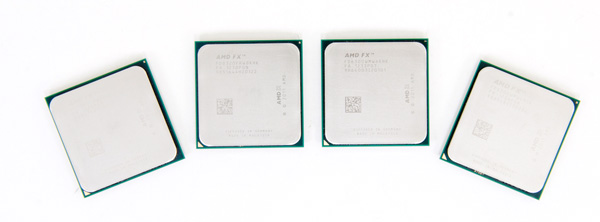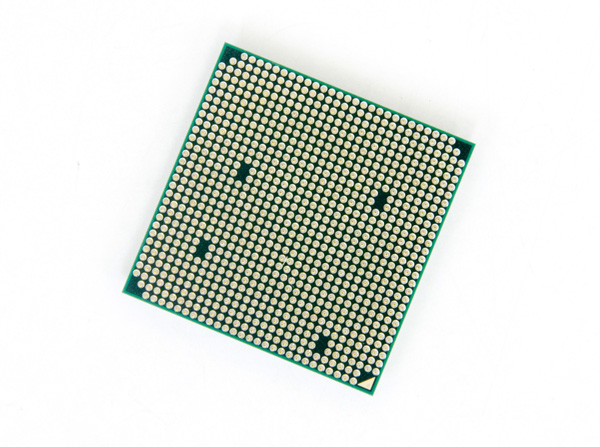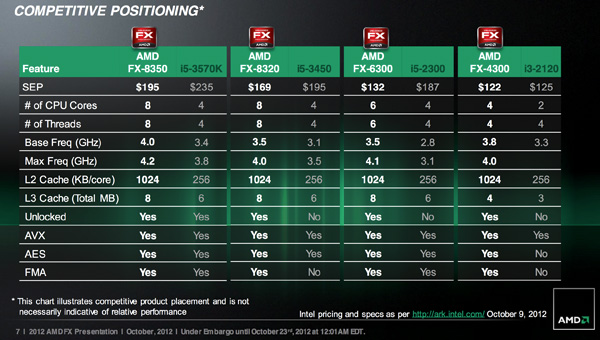The Vishera Review: AMD FX-8350, FX-8320, FX-6300 and FX-4300 Tested
by Anand Lal Shimpi on October 23, 2012 12:00 AM ESTLast year's launch of AMD's FX processors was honestly disappointing. The Bulldozer CPU cores that were bundled into each Zambezi chip were hardly power efficient and in many areas couldn't significantly outperform AMD's previous generation platform. Look beyond the direct AMD comparison and the situation looked even worse. In our conclusion to last year's FX-8150 review I wrote the following:
"Single threaded performance is my biggest concern, and compared to Sandy Bridge there's a good 40-50% advantage the i5 2500K enjoys over the FX-8150. My hope is that future derivatives of the FX processor (perhaps based on Piledriver) will boast much more aggressive Turbo Core frequencies, which would do wonders at eating into that advantage."
The performance advantage that Intel enjoyed at the time was beyond what could be erased by a single generation. To make matters worse, before AMD could rev Bulldozer, Intel already began shipping Ivy Bridge - a part that not only increased performance but decreased power consumption as well. It's been a rough road for AMD over these past few years, but you have to give credit where it's due: we haven't seen AMD executing this consistently in quite a while. As promised we've now had multiple generations of each platform ship from AMD. Brazos had a mild update, Llano paved the way for Trinity which is now shipping, and around a year after Zambezi's launch we have Vishera: the Piledriver based AMD FX successor.
At a high level, Vishera swaps out the Bulldozer cores from Zambezi and replaces them with Piledriver. This is the same CPU core that is used in Trinity, but it's optimized for a very different purpose here in Vishera. While Trinity had to worry about working nicely in a laptop, Vishera is strictly a high-end desktop/workstation part. There's no on-die graphics for starters. Clock speeds and TDPs are also up compared to Trinity.
| CPU Specification Comparison | ||||||||
| CPU | Manufacturing Process | Cores | Transistor Count | Die Size | ||||
| AMD Vishera 8C | 32nm | 8 | 1.2B | 315mm2 | ||||
| AMD Zambezi 8C | 32nm | 8 | 1.2B | 315mm2 | ||||
| Intel Ivy Bridge 4C | 22nm | 4 | 1.4B | 160mm2 | ||||
| Intel Sandy Bridge E (6C) | 32nm | 6 | 2.27B | 435mm2 | ||||
| Intel Sandy Bridge E (4C) | 32nm | 4 | 1.27B | 294mm2 | ||||
| Intel Sandy Bridge 4C | 32nm | 4 | 1.16B | 216mm2 | ||||
| Intel Lynnfield 4C | 45nm | 4 | 774M | 296mm2 | ||||
| Intel Sandy Bridge 2C (GT1) | 32nm | 2 | 504M | 131mm2 | ||||
| Intel Sandy Bridge 2C (GT2) | 32nm | 2 | 624M | 149mm2 | ||||
Vishera is still built on the same 32nm GlobalFoundries SOI process as Zambezi, which means there isn't much room for additional architectural complexity without ballooning die area, and not a whole lot of hope for significantly decreasing power consumption. As a fabless semiconductor manufacturer, AMD is now at GF's mercy when it comes to moving process technology forward. It simply has to make 32nm work for now. Piledriver is a light evolution over Bulldozer, so there's actually no substantial increase in die area compared to the previous generation. Cache sizes remain the same as well, which keeps everything roughly the same. These chips are obviously much larger than Intel's 22nm Ivy Bridge parts, but Intel has a full node advantage there which enables that.
Piledriver is a bit more power efficient than Bulldozer, which enables AMD to drive Vishera's frequency up while remaining in the same thermal envelope as Zambezi. The new lineup is in the table below:
| CPU Specification Comparison | ||||||||||
| Processor | Codename | Cores | Clock Speed | Max Turbo | L2/L3 Cache | TDP | Price | |||
| AMD FX-8350 | Vishera | 8 | 4.0GHz | 4.2GHz | 8MB/8MB | 125W | $199 | |||
| AMD FX-8150 | Zambezi | 8 | 3.6GHz | 4.2GHz | 8MB/8MB | 125W | $183 | |||
| AMD FX-8320 | Vishera | 8 | 3.5GHz | 4.0GHz | 8MB/8MB | 125W | $169 | |||
| AMD FX-8120 | Zambezi | 8 | 3.1GHz | 4.0GHz | 8MB/8MB | 125W | $153 | |||
| AMD FX-6300 | Vishera | 6 | 3.5GHz | 4.1GHz | 6MB/8MB | 95W | $132 | |||
| AMD FX-6100 | Zambezi | 6 | 3.3GHz | 3.9GHz | 6MB/8MB | 95W | $112 | |||
| AMD FX-4300 | Vishera | 4 | 3.8GHz | 4.0GHz | 4MB/4MB | 95W | $122 | |||
| AMD FX-4100 | Zambezi | 4 | 3.6GHz | 3.8GHz | 4MB/4MB | 95W | $101 | |||
The table above says it all. TDPs haven't changed, cache sizes haven't changed and neither have core counts. Across the board Vishera ships at higher base frequencies than the equivalent Zambezi part, but without increasing max turbo frequency (in the case of the 8-core parts). The 6 and 4 core versions get boosts to both sides, without increasing TDP. In our Trinity notebook review I called the new CPU core Bulldozed Tuned. The table above supports that characterization.
It's also important to note that AMD's pricing this time around is far more sensible. While the FX-8150 debuted at $245, the 8350 drops that price to $199 putting it around $40 less than the Core i5 3570K. The chart below shows where AMD expects all of these CPUs to do battle:
AMD's targets are similar to what they were last time: Intel's Core i5 and below. All of the FX processors remain unlocked and ship fully featured with hardware AES acceleration enabled. Most Socket-AM3+ motherboards on the market today should support the new parts with nothing more than a BIOS update. In fact, I used the same ASUS Crosshair V Formula motherboard I used last year (with a much newer BIOS) for today's review:

The Test
For more comparisons be sure to check out our performance database: Bench.
| Motherboard: | ASUS Maximus V Gene (Intel Z77) ASUS Crosshair V Formula (AMD 990FX) |
| Hard Disk: | Intel X25-M SSD (80GB) Crucial RealSSD C300 OCZ Agility 3 (240GB) Samsung SSD 830 (512GB) |
| Memory: | 4 x 4GB G.Skill Ripjaws X DDR3-1600 9-9-9-20 |
| Video Card: | ATI Radeon HD 5870 (Windows 7) NVIDIA GeForce GTX 680 (Windows 8) |
| Desktop Resolution: | 1920 x 1200 |
| OS: | Windows 7 x64/Windows 8 Pro x64 |













250 Comments
View All Comments
Melcinitan - Thursday, June 19, 2014 - link
sorry for bothering you chromatose,i feel to comment when i was reading yours. my comment is not regarding of yours.D0ubl3Tap - Sunday, February 9, 2014 - link
Tech support since the first ibm 88/66. AMD has its hits and misses. And i could argue tech benchmarks as well. But i buy my machines for reliability and stability. We supported 65k users with only 12 techs. 24/7 Phenom 2 was beautiful. so much to a point i just started field testing for a roll out for the 8320. So far Intel will still be what it is. (Apple, Intel, Samsung) Alot of money spent on hype. You wanna talk about whats real word useful? Well my friend the business world is all about documents of large size being transmitted and AMD's multi thread kicked the crap out of Intel in both time to completion and completion without error. Many many of our users game. Our test group did admit they loved the 8320 on A 970g. So the conclustion is If i wanna live in a box and run bench marks. Intel. I wanna get some tasks done AMD. Period, The added bonus my AMD vendors are so much easier to work with on the VERY rare occasion of a failure. Intel... not so much.quickbot - Monday, September 15, 2014 - link
Im at the moment looking for the best performance/price cpu, so after reading most of this i couldnt resist to comment. Clearly most of you here do OC and are a fkn benchmark freaks, while i play mmo's for 6-8 days you jiggle your PC in benchmarks, licking it and cooling off to get higher score.....but for what? Its like making a car with 300-400km/h and shitting on cars that barely do 200km/h, but forgetting the fact, that theres not many places where on daily basis you can go so fast, right?So im looking on game stats here as thats only thing that makes sense to me. So i was looking to buy 8350 a lil upgrade from my phenom II x4 965, but i started to wonder, why the hell i need so huge fps, if normaly you wont see any real difference between 60-70fps and 100. So i decided to buy 6350 and oc a bit as i read only good oc reviews about it. And yea, its not a huge difference in money, but still, im looking for a good build that wont hurt my pocket much. And to those who start to count electricity bills, you are stupid, NO gamer will use same system for 5 years, so saying to use 100usd more and buy intel is damn stupid, as in those 5 years i better save those 100usd and put em to a new amd cpu what they will have in that time.
I wont lie, i wanted to make intel pc as intel mobos are so much greater looking in my price range, but when i saw the price of cpus my dream was crashed. Here in Latvia i can buy FX-9370 4,4GHz almost cheaper than starting level i5 processor. If i compare only speed and reviews(as im only a gamer and dont know shit nor care about some numbers in tests, that intel has 5-10% better performance) then local store amd processors beat intel in price 2x. And for a simple(not making shitloads of money) gamer, price/performance is all what i need.
ofcourse these benchmark tests tell you alot more than to me, but really, if you have 200km/h car for 2k euro and 210km/h for 4k euro, then it all goes down only how much you can afford and if you really need, will use those extra 10km/h....right?
So please, stop bitching and telling total crap, as in end most people who buy these stuff are gamers, not overclockers who just need a better number is benchmark than guy next to him. Price is everything and even more price/performance. I better loose those 10% fps and still play game at 90% than pay 2x more to actually dont see any difference in daily basis.
Thats all!
Sorry about my english tho, its very bad, so dont even bother commenting on that as i wont get back here, just kinda made me sick all those idiots measuring theyre dicks in internet(for that join the chatroulette dick flashers)
analogbyte - Tuesday, October 28, 2014 - link
I just remember the days back in 2004, when Athlon destoyed intel's reputation. Jump ahead a few years, after intel failed twice with multicore architectures and they finally came through with core duo (their third attempt from scratch), after monopolizing an array of markets under the table (and finally losing in court years later, or too late, paying over 2 billion in damages to amd) and now, intel, the monarch in cpus, boasting their success over 5-10% performance against competition, being in that place after doing a lot of harm to their younger betters, still and always selling their products in a "milking" way, just makes me shake about our future. Buying amd's reasonably positioned products pricewise makes me feel I do my part in maintaining a much needed competition, that does everybody a lot of good. I think every amd customer offers intel customers faster progress and affordable prices. But not many willingly understand. Buying is a choice. And everybody needs amd but intel.arkitek4 - Wednesday, March 18, 2015 - link
I work as an Architect Specialist for a local Phil based company, I decided to purchase a new computer since my Acer Asphire with an Intel 2330 with a mistake of buying it without the benefit of a dedicated VRAM. When it came for me to learn Luminous 3.2 the laptop screen turned blue hence I am decided to buy a desktop PC.I conferred with our resident IT, and he sudjested for me to purchase a PC with an AMD processor since Intel even with their hyperthreading will just put most of my money on the CPU instead of opting for an AMD and slap it on with a 2GB dedicated VRAM 128 bit. Makes a lot of sense really and sadly with all the let-down statements about AMD I can only imagine a life without AMD where a whole lot of people won't be able to buy a simple ass PC on account of Intels exorbitant price range. Make no mistake though Intel really runs AMD down like a raging bull. But that is crap in the bag, speed isn't only the real issue here as the other components has to come into play. VRAM, RAMM speed and RAMM memory, motherboard, power supply, CPU case, cooling system, softwares. Add them all up and really with an AMD it can all be within arms reach as not everyone can afford Intel.
LikeClockwork64 - Thursday, December 24, 2015 - link
The FX 6300 is a great chip for gaming if the game actually utilizes all 6 cores. Since hyperthreading only adds up to 50% more performance, the i3 (which is the only chip within its price range) is actually more like a 3 core Intel processor. That's why the i5 beats it because it actually has a full 4 cores.Since the Piledriver cores are more than half as fast as Intel's that puts the FX6300 at above i3 performance in properly threaded games and within striking range of the i5. The FX8350 ends up being in between the i5 and i7 in games that like 8 threads. At less than $150 that makes the 8 core Piledriver chips very competitive with the i5.
If only games didn't emphasize the importance of the performance of the first two cores so much. AMD would have a serious winner with a 6 core APU
CosmicTrek - Tuesday, May 31, 2016 - link
You buy what you need for what you do, its not that complicated. If im building a budget pc aimed at being a "console killer" why would i spend around $300 for a i5 4690k and board when i can buy an equally priced board, and an fx 6300 for a little over $150 total which performs great in gaming, multitasking, and some mild video production? You pay for what you get. (Prices were found on newegg at the time of post)CosmicTrek - Tuesday, May 31, 2016 - link
The people that buy overkill hardware that they dont utilize 50% of, are the same people spending over $1000 for a gtx 1080 REFERENCE at launchKilon - Saturday, April 29, 2017 - link
I have a electricity flatrate and I mean it serious (I have no Idea, I only thought/think that AMD is doing stupid with saying its octo-core, its like the i3-540 I bought in 2010, it had 2 cores but 4 x 3.06 GHz... Intel stopped this when I bought this system, why is the power consumption soo important for the average user or is it something for the users who really know much? I thought max consumption is 125W and wondered about ~180-190W but its "System Power", I have ASUS M5 A97 R 2.0 Motherboard, I did not buy a new CPU yet because the prices are crazy because of the now very weak €uro to USD... Intel CPU's in late 2014 released at ~330€, exactly the same ones did cost in late 2016 ~350€! I have a PC since I'm 6-7 years old and I can't remember ever that 2 years after release a CPU is more expensive than at its release and the "new" ones are costing as much as a complete "low budget gaming"-system...So I use it, GTA 5 runes quite fine with 2,6GB of 2GB available VRAM (thanks to Nvidia Geforce Expierence, these settings are really cool, manually I can't make them, the game tells me I have not enough VRAM, but somehow the Geforce Software is able to do this, and its no prob, I'm a bit angry because I did not even try GTA 5 at this 8320/GTA 760 OC ASUS (1072 normal, OC to 1150 MHz, normal is 980 MHz and Turbo 1.033 I think, only 2GB VRAM @ 6008 MHz, I run it with ~6200)
So its ok to use the system like I did?! I sometimes pushed AMD Overclock a bit ahead, is it damaging my system??
Kilon - Saturday, April 29, 2017 - link
Sorry for posting again, I mean GTA 5 works really great (I did not try because GTA 4 is from 2008, the i3-540 is from 2010 and I had a HD 5770 which I overclocked from 850/1200 to 875-900/1250-1300 (GPU/VRAM), so a 2 year after GTA 4 was made CPU and a GPU which is not great but in 2010 was not crap was not able to play GTA 4 at everything max, now the GTA 5 runs really great and I "lost" over 1 year because I did not try (same with the free win 10 upgrade), the graphic is great, even with the 2,6GB settings, i wonder that the FX-8320 and the ASUS DirectCU-OC 760 works soo great at GTA 5! Only a few things are "off" which could be done by a 900-series I think,So I wonder, but maybe GTA 5 is simply one of the few games where it is like this and the other thing is the "optimized settings" from Geforce Experience, I would enable/do other settings, so I now enjoy it... but maybe GTA 5 already is a old game....